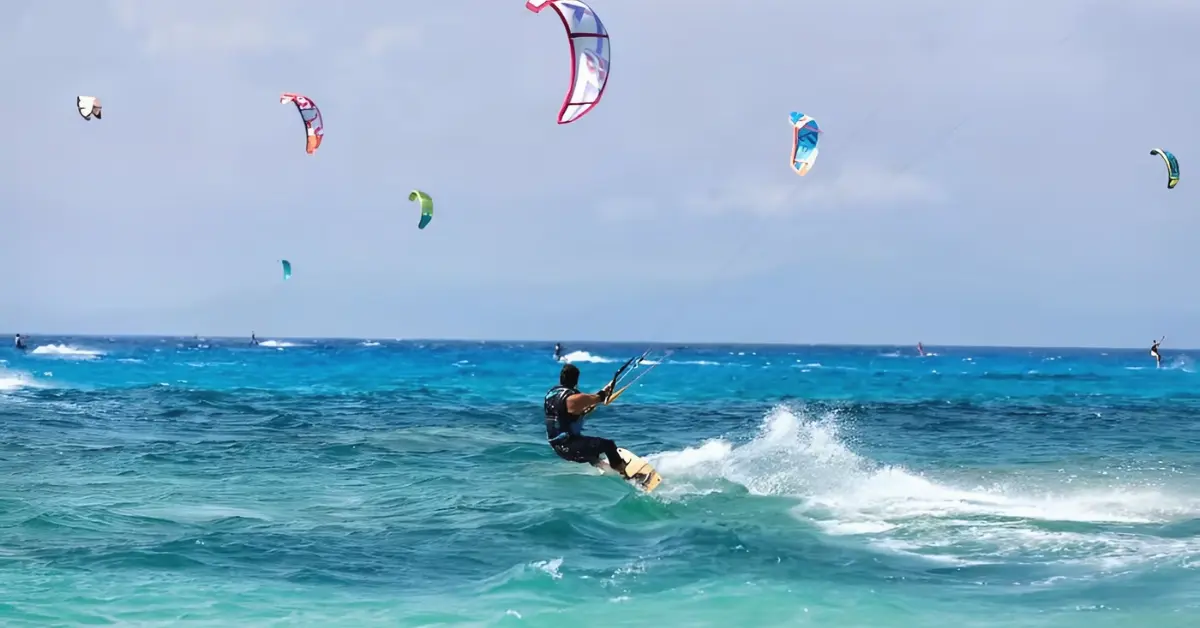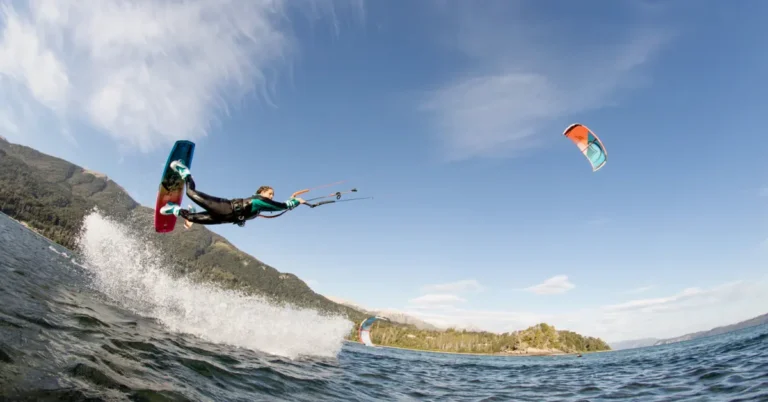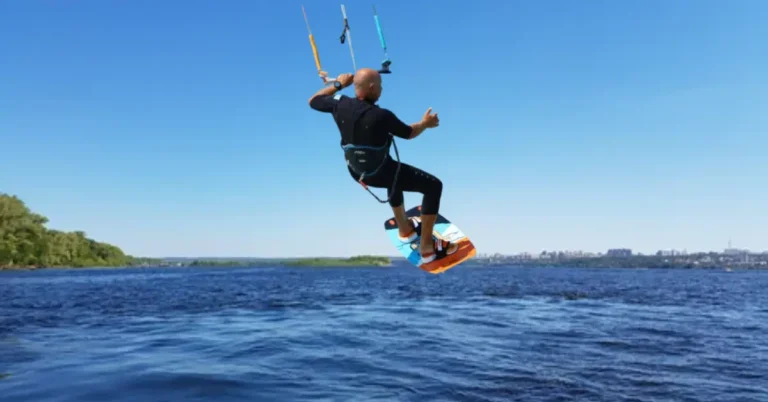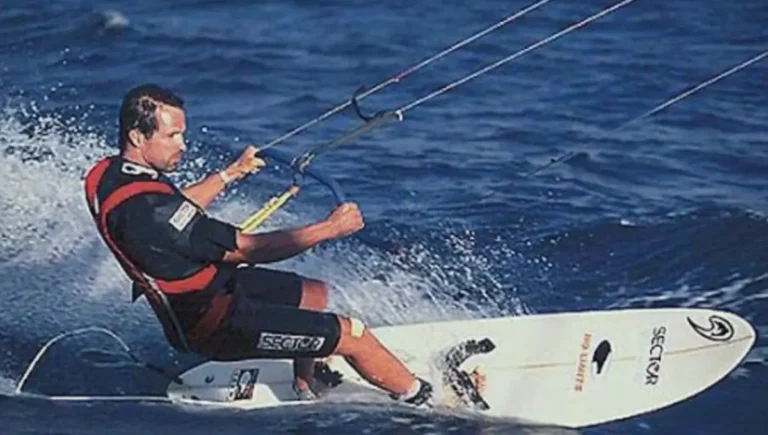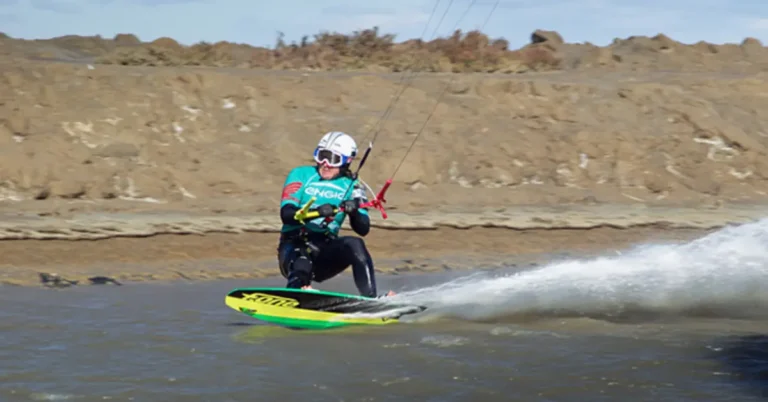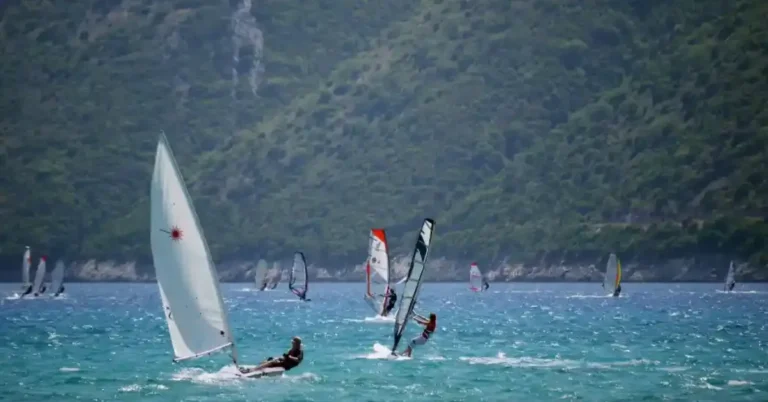What is Kitesurfing
Kitesurfing is a dynamic water sport that combines elements from various disciplines. Similar to surfing and wakeboarding, it involves riding a board. Drawing from windsurfing and sailing, it utilizes the power of the wind. Additionally, it incorporates a parachute-like kite, reminiscent of paragliding and parasailing. But how does this amalgamation manifest in practice?
In essence, kitesurfing entails using a sizable kite to propel oneself across the water while standing on a board. The kite is maneuvered using a control bar, enabling riders to harness the wind’s energy for maneuvers, tricks, and jumps, with the potential to reach heights exceeding 80 feet.
To kickstart their kitesurfing adventure, riders typically require a minimum wind speed of 10-12 knots (11.5-13.8 mph). The sweet spot for optimal conditions ranges from 18-25 knots (20.7-28.7 mph). Kitesurfers can achieve remarkable speeds, with the current record held by Rob Douglas, who soared at an incredible 55.65 knots (63.79 mph)!
Also Read: kitesurfing work
What is Kitesurfing vs Windsurfing
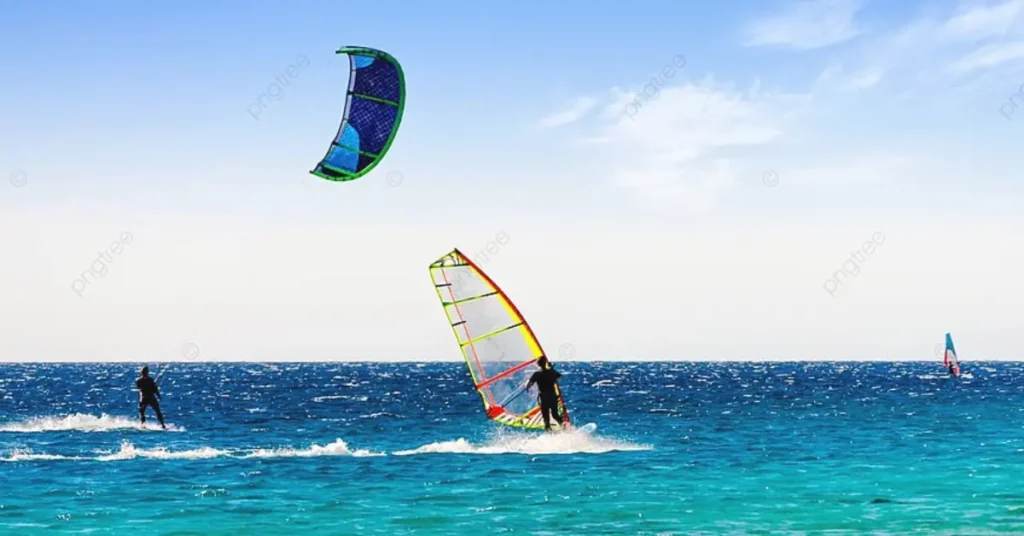
While both windsurfing and kitesurfing harness wind power for surface water sports, they employ distinct equipment and yield different outcomes. Kitesurfing is characterized by its smaller and more agile setup compared to windsurfing. The board is compact, and the gear tends to be lighter. Notably, kitesurfing utilizes a canopy rather than a traditional sail, emphasizing maneuverability.
This discrepancy in equipment hints at a fundamental difference between the two sports. while windsurfing remains primarily on the water’s surface, kitesurfing allows enthusiasts to soar into the air. Additionally, kitesurfers are tethered to both their board and their kite, enhancing control and stability, whereas a windsurf sail is solely connected to the board.
What is Kitesurfing vs Surfing
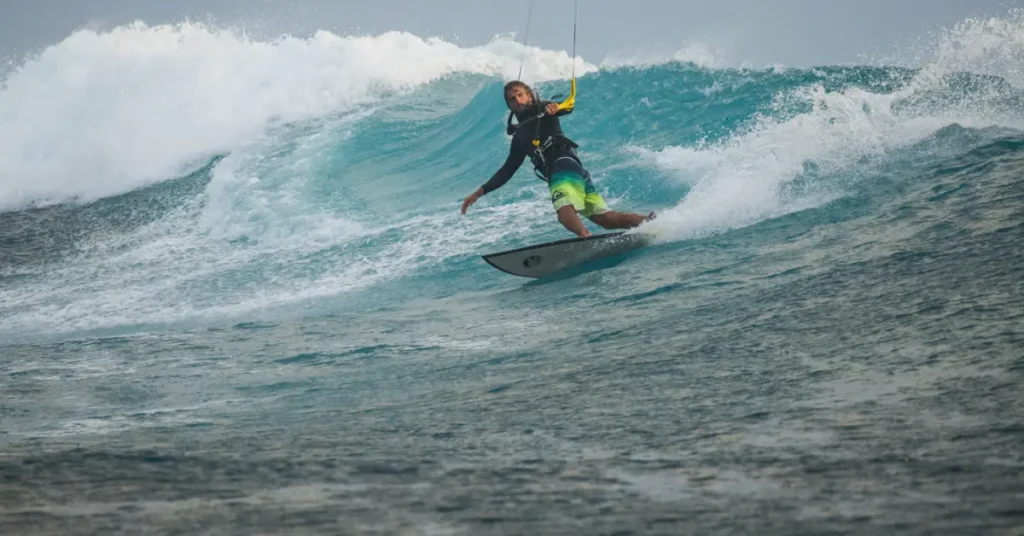
Surfing diverges from kitesurfing not only due to the absence of a kite but also because it depends on the existence of waves. Conversely, kitesurfing is versatile and can be practiced on flat waters just as effectively. Remarkably, kiteboarding enthusiasts can even engage in the sport on land.
Kitesurfing Explained
Understanding the mechanics of kitesurfing delves into aerodynamics and scientific principles, including equations and Newton’s third law of motion. Simplifying it, the flight of the kite hinges on the interplay of lift, drag, thrust, and weight, and how they are balanced. When the wind encounters the kite, air flows both over and under its surface.
The curved canopy of the kite necessitates a longer path for the air above compared to below. Consequently, the air above moves faster, exerting less pressure on the kite than the air below, resulting in more lift than drag, thus lifting the kite.
The “wind window” refers to the area where the kite can fly. It’s not static but rather a zone downwind from the kitesurfer, centered around them. This imaginary arc spans 180 degrees, with sections indicating the kite’s optimal flying conditions.
Now, the harness connects the kite and the surfer. Multiple lines link the two, with a bar enabling the kitesurfer to adjust the kite’s angle and line length. Firstly, the tethering creates drag, aiding the kite’s flight. Additionally, altering the kite’s position allows the surfer to modify its interaction with the wind, enabling speed adjustments.
History of Kitesurfing
The history of kitesurfing is intertwined with the evolution of its constituent sports, from the development of various parachutes and canopies to wakeboards and surfboards. Patents for kitesurfing, or early iterations thereof, trace back to the 1970s, with notable innovators including the French Legaignoux brothers and the American father-son duo, Bill and Cory Roeseler, founders of KiteSki.
The late 1990s marked a significant turning point for kitesurfing, with the inaugural competition held in Maui in 1998. Windsurfing manufacturers such as Neil Pryde and Robby Naish began producing commercial kiteboards as early as 1999, further propelling the sport’s growth.
Kitesurfing’s popularity has soared, partly due to its perceived accessibility compared to similar sports like windsurfing. As its following has expanded, so too has the range of kitesurfing disciplines, including slalom, freestyle, speed, wave riding, big air, and land-based variants like kite buggying.
On the global sporting stage, kitesurfing has been featured in the ISAF World Sailing World Cup since 2014 and was included in the 2018 Summer Youth Olympics. Moreover, it has gained recognition as an Olympic sport, solidifying its status as a prominent water sports discipline.
What Equipment do you need for Kitesurfing?
First and foremost, kitesurfing revolves around the use of a kite—a fabric rectangular canopy typically crafted from ripstop polyester. There are two primary types of kites used in the sport: foil and inflatable.
Inflatables, formally referred to as Leading Edge Inflatables, are typically constructed from ripstop polyester. They feature inflatable plastic bladders, usually positioned at the front and rear of the canopy. These bladders not only maintain the kite’s shape but also aid in flotation and facilitate easier launching.
Foils, on the other hand, do not incorporate inflatable components. They rely on airflow to fill their cells and provide structure. Although they may be more challenging to handle, foils are often favored for their greater power output.
Regarding shape and size, various factors come into play, including the surfer’s physique, surfing style, and level of experience. Moreover, different weather conditions call for different kite sizes, although sizes generally range from 5 to 18 square meters.
Harness, Control Bar, and Lines
The kitesurfer is either seated in or securely strapped into a harness, which is linked to the kite via two to five ropes, known as “flying lines.” These lines are crafted from durable materials like polyethylene and are threaded through the control bar, a rod that the kitesurfer utilizes to steer and maneuver the kite.
What is a Kiteboard?
A kiteboard is the essential equipment that facilitates gliding on the water for kitesurfers. While its purpose might seem straightforward, understanding its construction and differences from boards used in other water sports is key.
Kiteboards are rectangular floating boards exclusively designed for kitesurfing or kiteboarding. Typically ranging from 3.5 to 5.5 feet in length and about 1.5 feet in width, they are notably smaller compared to towering surfboards.
These boards generally fall into two categories: twin tip or directional. Twintip kiteboards feature a symmetrical shape, allowing for use in any direction, while directional kiteboards are designed to travel in one specific direction.
Twintip kiteboards often have a wooden core, similar to snowboards, while directional kiteboards typically have a foam core akin to surfboards. Both variations are encased in durable yet lightweight materials like fiberglass.
What is a Kiteboard versus a Wakeboard?
Kiteboards and wakeboards share a striking resemblance, characterized by their smaller size compared to surfboards and rectangular shape.
Nevertheless, there are notable differences between the two. Wakeboards typically feature a more pronounced bottom curve, known as the “rocker,” which aids in achieving higher speeds. Additionally, kiteboards often incorporate foot marking systems to assist in performing tricks or jumps that necessitate separation between the surfer and the board.
Furthermore, while wakeboards typically weigh between 7 to 8 pounds, kiteboards are notably lighter, weighing in at approximately 5 to 6 pounds.
What Equipment do you need for Kitesurfing? Clothing and Safety Gear
To ensure safety during kitesurfing, it’s essential to have the following equipment:
With these essentials, along with understanding the history of kitesurfing and knowing the necessary equipment, you’re prepared to take flight on the waves.
Learn kitesurfing with The Kitesurf Centre
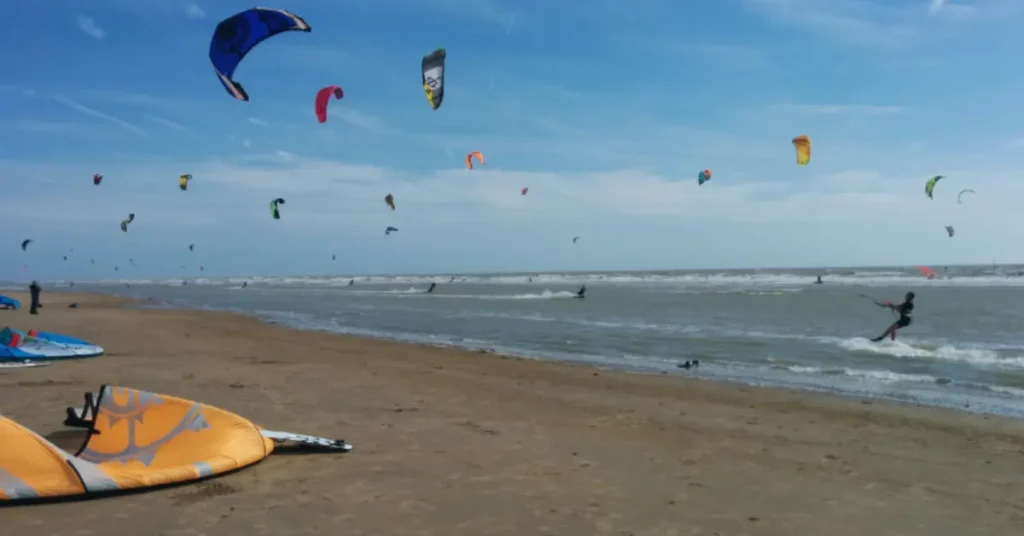
Kitesurfing is a thrilling water sport that uses a large kite and a board to glide across the water’s surface. Unlike traditional surfing, kitesurfing doesn’t rely on waves; instead, it harnesses the power of the wind to propel riders. Kitesurfing equipment includes a kite, which is inflatable and helps hold its shape and float on the water. There are different sizes of kites, ranging from 2 to 14 square meters, chosen based on wind strength and rider size.
There are two main types of kites. C-kites, which have a curved shape, and bow or SLE (supported leading edge) kites, which have a flatter shape and bridle lines for added support. The board used in kitesurfing is called a kiteboard or kiteboard, which is similar to a wakeboard but smaller and lighter. Kiteboards can be either twin-tip, allowing riders to travel in any direction, or directional, which are used primarily for riding waves. They come in various sizes, typically ranging from 125 to 150 centimeters in length and 38 to 45 centimeters in width.
Kitesurfing is suitable for a wide range of wind conditions, making it more versatile than windsurfing. It draws inspiration from other sports like wakeboarding, snowboarding, and surfing, making it easy for people with diverse backgrounds to pick up. One of the significant benefits of kitesurfing is its full-body workout. Riders use their legs to control the board, while their abs and arms maintain balance and control of the kite. Once in the water, a harness takes the strain off, allowing for extended sessions without fatigue.
Frequently Asked Questions
Conclusion
Kitesurfing is an exhilarating water sport where riders use a large kite and a board to glide across the water’s surface, propelled by the power of the wind. Unlike traditional surfing, which relies on waves, kitesurfing offers versatility, allowing for riding in both wave and flat water conditions.
With the right equipment and instruction, beginners can quickly pick up the sport and start enjoying its full-body workout and thrilling experiences. Overall, kitesurfing provides an accessible and exciting way to connect with nature and enjoy the freedom of riding the wind and waves.
